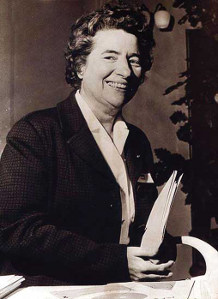Women in Nuclear History: Marguerite Perey
Marguerite Perey (1909-1975) was a French scientist and a student of Marie Curie, credited with discovery of the element francium by purifying samples of lanthanum that contained actinium. In 1962, she was the first woman to be elected to the French Académie des Sciences, an honor denied to her mentor Curie. Perey died of cancer in 1975.
- Perey earned a chemistry diploma from Paris’ Technical School of Women’s Education in 1929; while not a “degree”, it did qualify her to work as a chemistry technician.
- At the age of 19, she interviewed for a job with Marie Curie at Curie’s Radium Institute in Paris, France, and was hired. Marie Curie took on a mentoring role to Perey.
- Marie Curie died of aplastic anemia only five years after Perey began working with her, but Perey and André-Louis Debierne (credited with isolating actinium) continued their research on purifying actinium, that had to be sift from uranium ore, and Perey was promoted to radiochemist.
- In 1935, Perey read a paper by American scientists claiming to have discovered beta radiation being emitted by actinium mix, and was skeptical because the reported energy of the beta particles didn’t seem to match actinium, but rather a daughter atom created after alpha decay. She decided to investigate for herself, she ended up with discovering francium, an element with 87 protons that emits beta and also alpha radiation, was derived from actinium mix, and it is a part of alkali metals.
- Perey announced the discovery as a note in the “Comptes Rendus” presented at the Académie des Sciences by Jean Baptiste Perrin on January 9, 1939 with the title “On an element 87, derived from actinium.” Perey’s discovery was announced by Perrin, not Perey herself, because she was only a laboratory assistant with no university degree. Perey named the element francium, after her home country.
- She graduated from the Sorbonne in 1946 with a Doctorate of Physics. After obtaining her PhD, Perey returned to the Radium Institute as a senior scientist and worked there until 1949.
- In 1949, Perey was made the head of the department of nuclear chemistry at the University of Strasbourg, where she developed the University’s radiochemistry and nuclear chemistry program and continued her work on francium.
- In 1962, she was the first woman elected to the French Académie des Sciences, an honor denied to her mentor Curie. Because of her work with francium. Perey was nominated five times for a Nobel Prize, but she never received it.
- Ironically Perey hoped that francium would help diagnose cancer, but in fact it itself was carcinogenic, and Perey developed bone cancer which eventually killed her. Perey died on May 13, 1975 (age 65).
- Francium is the second rarest element (after astatine) – only about 550 g exists in the entire earth’s crust – and it was the last element to be discovered in nature. Francium is one of the most unstable of the naturally occurring elements: its longest-lived isotope, francium-223, has a half-life of only 22 minutes. Five elements that were discovered synthetically were later found to exist in nature: technetium, promethium, astatine, neptunium, and plutonium.

References:
https://scientificwomen.net/women/perey-marguerite-147
https://en.wikipedia.org/wiki/Marguerite_Perey
https://uwaterloo.ca/chem13-news-magazine/april-2015/feature/engaging-story-marguerite-perey